
Eucalyptus haemastoma, commonly known as scribbly gum, is a species of tree that is endemic to the Sydney region. It has white or silvery grey bark, lance-shaped or curved adult leaves, flower buds in groups of between nine and fifteen, white flowers and conical or hemispherical fruit. It is one of several eucalypts with prominent and differing insect scribbles in the bark, caused by the larvae of Ogmograptis,.

No. 4 Squadron is a Royal Australian Air Force squadron composed of the air force special forces Combat Controllers, aircrew who operate the Pilatus PC-21 aircraft and instructors for the Australian Defence Force Joint Terminal Attack Controller (JTAC) course.

Banksia grandis, commonly known as bull banksia or giant banksia, is a species of common and distinctive tree in the south-west of Western Australia. The Noongar peoples know the tree as beera, biara, boongura, gwangia, pira or peera. It has a fire-resistant main stem with thick bark, pinnatisect leaves with triangular side-lobes, pale yellow flowers and elliptical follicles in a large cone.

Eucalyptus melliodora, commonly known as yellow box, honey box or yellow ironbark, is a species of medium-sized to occasionally tall tree that is endemic to south-eastern, continental Australia. It has rough, flaky or fibrous bark on part or all of the trunk, smooth greyish to yellowish bark above. The adult leaves are lance-shaped to egg-shaped, the flower buds are arranged in groups of seven and the fruit is more or less hemispherical.

Eucalyptus moluccana, commonly known as the grey box, gum-topped box or terriyergro, is a medium-sized to tall tree with rough bark on part or all of the trunk, smooth bark above, lance-shaped adult leaves, flower buds usually in groups of seven, white flowers and cup-shaped to barrel-shaped fruit. It is found in near-coastal areas of Queensland and New South Wales.

Eucalyptus dumosa, commonly known as the white mallee, dumosa mallee, or Congoo mallee, is a species of mallee that is endemic to south eastern Australia. It usually has rough, flaky grey bark on the lower trunk, smooth bark above, lance-shaped to curved adult leaves, flower buds in groups of seven, white flowers and cup-shaped, cylindrical or barrel-shaped fruit.

Eucalyptus microcarpa, commonly known as grey box, is a species of tree that is endemic to southeastern continental Australia. It has rough, fibrous or flaky bark on the trunk, smooth whitish bark above, lance-shaped adult leaves, flower buds in groups of between seven and eleven, white flowers and oval, cylindrical or urn-shaped fruit.
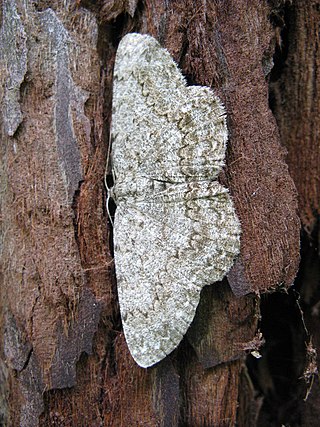
The Boarmiini are a large tribe of geometer moths in the Ennominae subfamily.

Discophlebia catocalina, the yellow-tailed stub moth is an Australian moth species found in the south-eastern quartile of Australia. It is classified within the Oenosandridae moth family in the Noctuoidea Superfamily, the largest superfamily of the Order Lepidoptera. It is visually recognised by its characteristic pointed yellow tail and is a medium-sized moth species with a wingspan range of 40mm-60mm depending on gender. Discophlebia Catocalina have evolved to feed on various species of eucalypt.
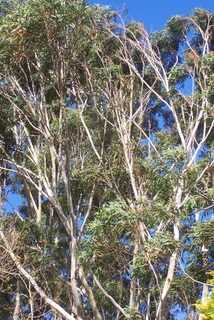
Eucalyptus pilularis, commonly known as blackbutt, is a species of medium-sized to tall tree that is endemic to eastern Australia. It has rough, finely fibrous greyish bark on the lower half of the trunk, smooth white, grey or cream-coloured bark above, lance-shaped to curved adult leaves, flower buds in groups of between seven and fifteen, white flowers and hemispherical or shortened spherical fruit.
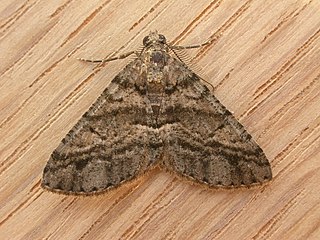
Lipogya is a genus of moths in the family Geometridae described by Warren in 1898. All are from Australia.

Corymbia terminalis, also known as tjuta, joolta, bloodwood, desert bloodwood, plains bloodwood, northern bloodwood, western bloodwood or inland bloodwood, is a species of small to medium-sized tree, rarely a mallee that is endemic to Australia. It has rough, tessellated bark on some or all of the trunk, sometimes also on the larger branches, smooth white to cream-coloured bark above, lance-shaped adult leaves, flower buds in groups of seven, white flowers and urn-shaped fruit.

Eucalyptus blakelyi, known as Blakely's red gum, is a tree endemic to eastern Australia. It has smooth bark on its trunk and branches, dull bluish green, lance-shaped adult leaves, flower buds usually in groups of seven, white flowers and cup-shaped to hemispherical fruit.
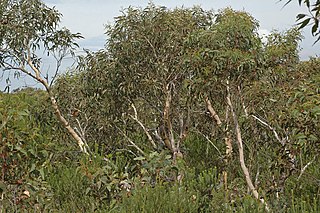
Eucalyptus racemosa, commonly known as snappy gum or narrow-leaved scribbly gum, is a species of small to medium-sized tree that is endemic to eastern Australia. It has smooth, mottled bark, lance-shaped to curved or egg-shaped adult leaves, flower buds in groups of between seven and fifteen, white flowers and cup-shaped, conical or hemispherical fruit.
Ichneumenoptera chrysophanes, the clearwing persimmon borer, is a moth of the family Sesiidae. It is found from Cairns in Queensland to Canberra in the Australian Capital Territory.

Xyloryctidae is a family of moths contained within the superfamily Gelechioidea described by Edward Meyrick in 1890. Most genera are found in the Indo-Australian region. While many of these moths are tiny, some members of the family grow to a wingspan of up to 66 mm, making them giants among the micromoths.
Idioglossa metallochrysa is a very small species of golden-metallic coloured moth of the family Batrachedridae living in a subtropical highland climate, at least in Australia, and of which the caterpillars feed on the plant Cheilocostus speciosus, at least in Indonesia.
Gonioma hypoxantha is a moth in the family Xyloryctidae. It was described by Oswald Bertram Lower in 1894. It is found in Australia, where it has been recorded from Queensland.
Xylorycta conistica is a moth in the family Xyloryctidae. It was described by Alfred Jefferis Turner in 1917. It is found in Australia, where it has been recorded from Queensland.
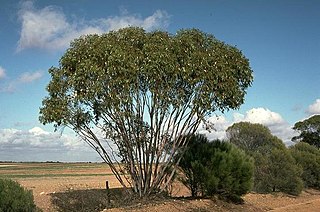
Eucalyptus stowardii, commonly known as fluted-horn mallee, is a species of mallee that is endemic to the south-west of Western Australia. It has smooth bark, lance-shaped adult leaves, flower buds in groups of seven, creamy white flowers and ribbed, cylindrical to cup-shaped fruit.
















